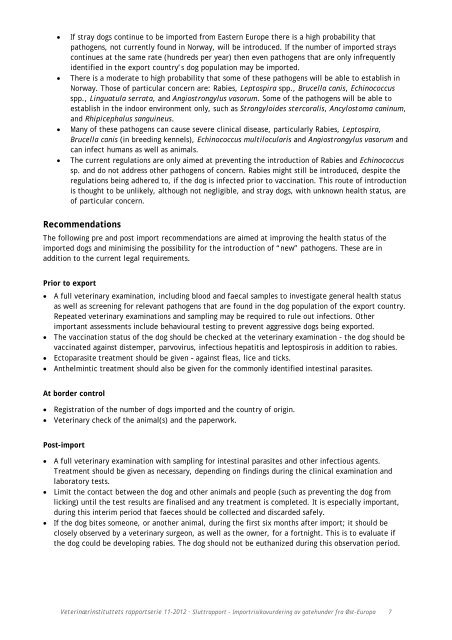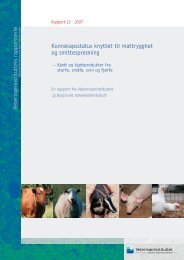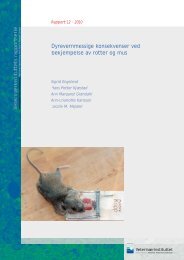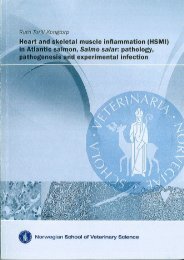Last ned fullversjon - Veterinærinstituttet
Last ned fullversjon - Veterinærinstituttet
Last ned fullversjon - Veterinærinstituttet
Create successful ePaper yourself
Turn your PDF publications into a flip-book with our unique Google optimized e-Paper software.
If stray dogs continue to be imported from Eastern Europe there is a high probability that<br />
pathogens, not currently found in Norway, will be introduced. If the number of imported strays<br />
continues at the same rate (hundreds per year) then even pathogens that are only infrequently<br />
identified in the export country’s dog population may be imported.<br />
There is a moderate to high probability that some of these pathogens will be able to establish in<br />
Norway. Those of particular concern are: Rabies, Leptospira spp., Brucella canis, Echinococcus<br />
spp., Linguatula serrata, and Angiostrongylus vasorum. Some of the pathogens will be able to<br />
establish in the indoor environment only, such as Strongyloides stercoralis, Ancylostoma caninum,<br />
and Rhipicephalus sanguineus.<br />
Many of these pathogens can cause severe clinical disease, particularly Rabies, Leptospira,<br />
Brucella canis (in breeding kennels), Echinococcus multilocularis and Angiostrongylus vasorum and<br />
can infect humans as well as animals.<br />
The current regulations are only aimed at preventing the introduction of Rabies and Echinococcus<br />
sp. and do not address other pathogens of concern. Rabies might still be introduced, despite the<br />
regulations being adhered to, if the dog is infected prior to vaccination. This route of introduction<br />
is thought to be unlikely, although not negligible, and stray dogs, with unknown health status, are<br />
of particular concern.<br />
Recommendations<br />
The following pre and post import recommendations are aimed at improving the health status of the<br />
imported dogs and minimising the possibility for the introduction of “new” pathogens. These are in<br />
addition to the current legal requirements.<br />
Prior to export<br />
A full veterinary examination, including blood and faecal samples to investigate general health status<br />
as well as screening for relevant pathogens that are found in the dog population of the export country.<br />
Repeated veterinary examinations and sampling may be required to rule out infections. Other<br />
important assessments include behavioural testing to prevent aggressive dogs being exported.<br />
The vaccination status of the dog should be checked at the veterinary examination - the dog should be<br />
vaccinated against distemper, parvovirus, infectious hepatitis and leptospirosis in addition to rabies.<br />
Ectoparasite treatment should be given – against fleas, lice and ticks.<br />
Anthelmintic treatment should also be given for the commonly identified intestinal parasites.<br />
At border control<br />
Registration of the number of dogs imported and the country of origin.<br />
Veterinary check of the animal(s) and the paperwork.<br />
Post-import<br />
A full veterinary examination with sampling for intestinal parasites and other infectious agents.<br />
Treatment should be given as necessary, depending on findings during the clinical examination and<br />
laboratory tests.<br />
Limit the contact between the dog and other animals and people (such as preventing the dog from<br />
licking) until the test results are finalised and any treatment is completed. It is especially important,<br />
during this interim period that faeces should be collected and discarded safely.<br />
If the dog bites someone, or another animal, during the first six months after import; it should be<br />
closely observed by a veterinary surgeon, as well as the owner, for a fortnight. This is to evaluate if<br />
the dog could be developing rabies. The dog should not be euthanized during this observation period.<br />
<strong>Veterinærinstituttet</strong>s rapportserie 11-2012 · Sluttrapport - Importrisikovurdering av gatehunder fra Øst-Europa 7







